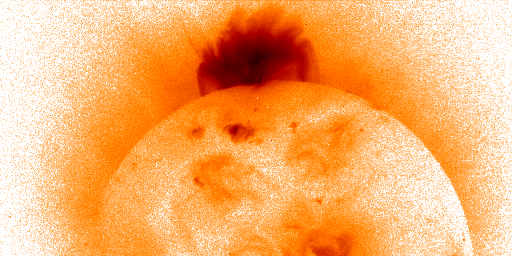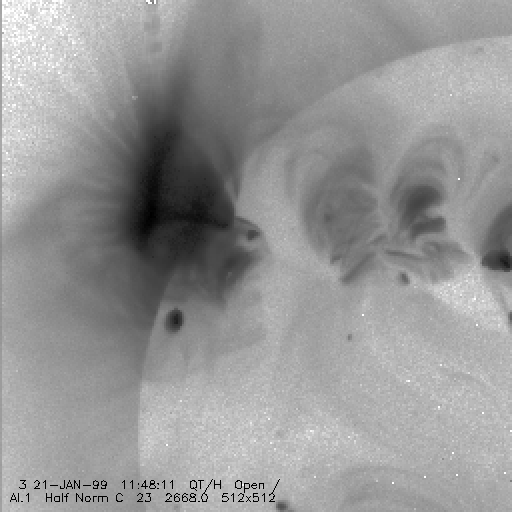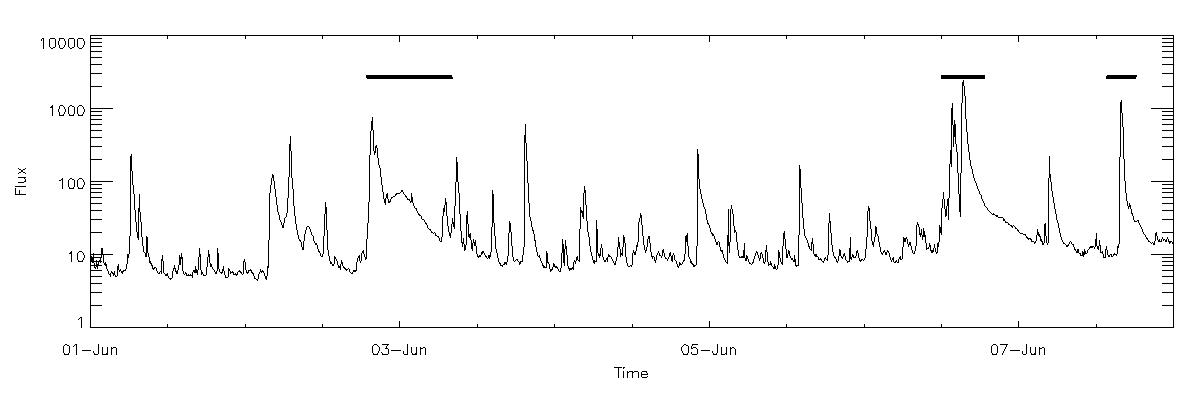
We've often seen arcade events in the Yohkoh soft X-ray data. Arcade events, of course, are those bright semi-cylindrical X-ray loop systems, known since Skylab's pioneering soft X-ray images (unfortunately, the amazing Skylab preceded digital imagery and it's hard to find solar X-ray images on the Web). However these arcades, which correspond to long-decay X-ray bursts and to coronal mass ejections, taught us a great deal about how the corona works - for example, it led to many theories of magnetic reconnection in the coronal magnetic field.
Yohkoh X-ray images show these arcades very well, and have made a new contribution: the "spiny arcades", whose observation has resulted in some of Yohkoh's most interesting discoveries. The prototype of these events occurred on August 28, 1992:

Here, by artistic license, the W limb of the Sun has been rotated to the top of the figure. These have somewhat the appearance of a porcupine, and the spines can often be traced as far out into the corona as SXT's CCD detector will allow - approaching one solar radius above the photosphere:

In most arcade events the corona above the X-ray loops initially appears dark, prior to the appearance of the spines if they do form. In fact, its darkness results from one of the Yohkoh discoveries: X-ray dimming, in which the first event above played a role. The second event above led to the a second discovery, namely the "supra-arcade downflows" which we think show the direct result of large-scale coronal reconnection following the flare that caused the dimming in the first place.
This leads up to the fact that we just observed another such event on June 2, 2000, in a quite interesting active region that later produced X-class flares. The plot below shows a week in the life of the Sun in the form of its soft X-ray flux (click to clarify):

The heavy bar at about June 3 shows when the spiny arcade appeared; the shorter bars on June 6 and 7 show the times of the X-class flares. In between these times other remarkable things were happening, not described here for lack of time and space - but, would you believe a giant cusp that lies in a plane? At least, from the fact that the spiny arcade preceded the X-class flares, we might infer that the global structure of a solar active region can disrupt even relatively early in its life cycle. One might have speculated that middle-aged regions could be more prone to eruption as their magnetic fields comfortably spread out - there may be some sort of anthropomorphic parallel here.
Our June 2 event also resulted in coronal dimming:

Here two images from before and after sandwich a difference image, in which the black region above the arcade shows the removal of the corona by the flare. Unfortunately this event was not intense enough to give flare-mode images, and hence a good movie, from which we could detect the supra-arcade downflows. But they were surely there, based on our experience.
In fact, we are grateful for the existence of these spiny arcades, since they have led to discoveries, but what causes them? They have a characteristic spatial scale very roughly that of the chromospheric network (supergranulation), but what physically causes them to be bright? The spines seem to baffle theorists, who characteristically just shrug when asked about them - except for the eminent E. Priest, who pointed out the possible connection to the supergranulation magnetic scale. McKenzie's cartoon, taken from the Grand Archive of Cartoons, is about the best we can do right now. We conjecture that the brightness of the spines, and their detailed structure, may result from the transient flow of enhanced solar wind resulting from the field lines opened by the eruption, as suggested by Z. Svestka, who in fact analyzed the event at the top of the page. The spines tend to develop late in the event, as do the large-scale cusps that we also often see associated with arcades; but if the spines are just mini-cusps (and they seem to map one-to-one to arcade bright loops) what is the 3D structure of the magnetic field? No theories yet exist, so this may be your chance to make a big contribution!
July 7, 2000
Hugh Hudson (hudson@isass1.solar.isas.ac.jp)